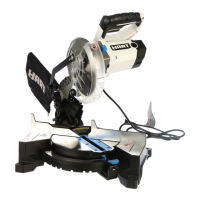2 – English
WARNING:
Read all safety warnings, instructions, illustrations
and specifications provided with this power tool.
Failure to follow all instructions listed below may result
inelectricshock,fireand/orseriousinjury.
Save all warnings and instructions for future reference.
Theterm“powertool”inthewarningsreferstoyourmains-
operated(corded)powertoolorbattery-operated(cordless)
powertool.
WORK AREA SAFETY
Keep work area clean and well lit. Clutteredordark
areasinviteaccidents.
Do not operate power tools in explosive atmospheres,
such as in the presence of flammable liquids, gases
or dust.Powertoolscreatesparkswhichmayignitethe
dustorfumes.
Keep children and bystanders away while operating a
power tool. Distractionscancauseyoutolosecontrol.
ELECTRICAL SAFETY
Power tool plugs must match the outlet. Never modify
the plug in any way. Do not use any adapter plugs with
earthed (grounded) power tools. Unmodifiedplugsand
matchingoutletswillreduceriskofelectricshock.
Avoid body contact with earthed or grounded surfac-
es, such as pipes, radiators, ranges and refrigerators.
Thereisanincreasedriskofelectricshockifyourbody
isearthedorgrounded.
Do not expose power tools to rain or wet conditions.
Waterenteringapowertoolwillincreasetheriskofelec-
tricshock.
Do not abuse the cord. Never use the cord for carrying,
pulling or unplugging the power tool. Keep cord away
from heat, oil, sharp edges or moving parts. Damaged
orentangledcordsincreasetheriskofelectricshock.
When operating a power tool outdoors, use an exten-
sion cord suitable for outdoor use. Use of a cord suit-
ableforoutdoorusereducestheriskofelectricshock.
If operating a power tool in a damp location is un-
avoidable, use a ground fault circuit interrupter (GFCI)
protected supply. Use ofaGFCIreduces the risk of
electricshock.
PERSONAL SAFETY
Stay alert, watch what you are doing and use com-
mon sense when operating a power tool. Do not use
a power tool while you are tired or under the influence
of drugs, alcohol or medication. A moment of inatten-
tionwhileoperating powertoolsmay resultinserious
personalinjury.
Use personal protective equipment. Always wear eye
protection.Protective equipment suchasdustmask,
non-skidsafety shoes,hardhat,orhearingprotection
usedforappropriate conditions willreduce personal
injuries.
Prevent unintentional starting. Ensure the switch is in
the off-position before connecting to power source
and/or battery pack, picking up or carrying the tool.
Carryingpowertoolswithyourfingerontheswitchor
energizingpowertoolsthathavetheswitchoninvites
accidents.
Remove any adjusting key or wrench before turning
the power tool on. Awrenchorakeyleftattachedto
arotatingpartofthepowertoolmayresultinpersonal
injury.
Do not overreach. Keep proper footing and balance
at all times. Thisenablesbettercontrolofthepowertool
inunexpectedsituations.
Dress properly. Do not wear loose clothing or jewelry.
Keep your hair, clothing and gloves away from moving
parts. Looseclothes,jewelryorlonghaircanbecaught
inmovingparts.
If devices are provided for the connection of dust
extraction and collection facilities, ensure these are
connected and properly used. Use of dust collection
canreducedust-relatedhazards.
Do not let familiarity gained from frequent use of tools
allow you to become complacent and ignore tool
safety principles. Acarelessactioncancausesevere
injurywithinafractionofasecond.
POWER TOOL USE AND CARE
Do not force the power tool. Use the correct power
tool for your application. Thecorrect powertool will
dothejobbetterandsaferattherateforwhichitwas
designed.
Do not use the power tool if the switch does not turn
it on and off.Anypowertoolthatcannotbecontrolled
withtheswitchisdangerousandmustberepaired.
GENERAL SAFETY RULES

